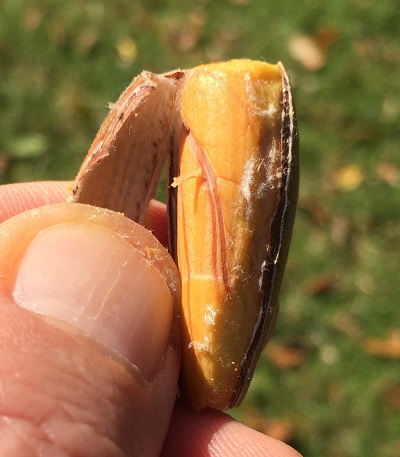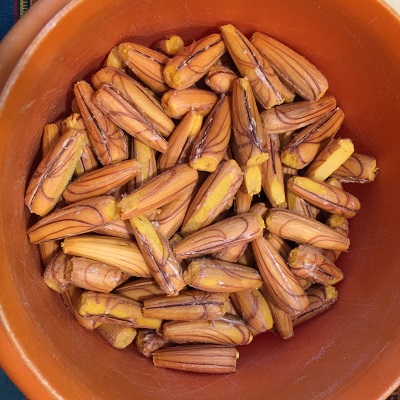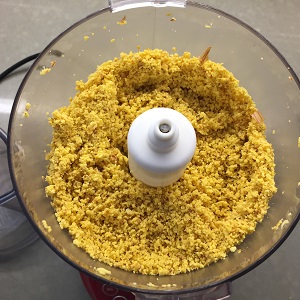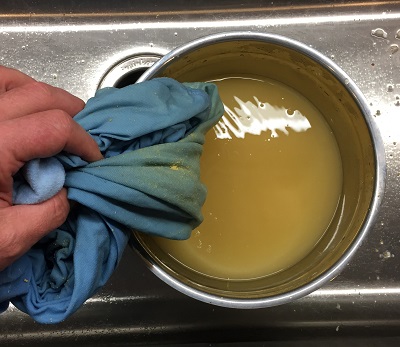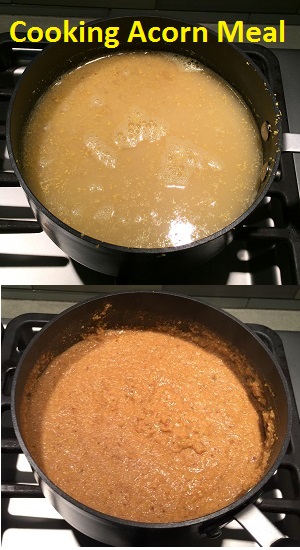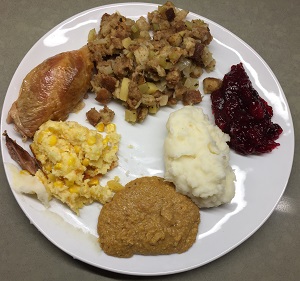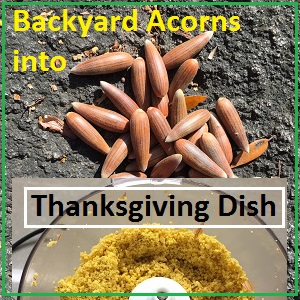
Converting my backyard Live Oak acorns into a Thanksgiving meal side dish.
With just four Live Oaks (Quercus agrifolia nee) in my backyard, I will usually rake up 2 to 3 wheelbarrow loads of acorns every fall. Until I started reading about Maidu Native Americans that lived in the Granite Bay area of California, I hadn’t considered acorns as a food source. After I had documented numerous Native American acorn grinding-hole sites around Folsom Lake, I figured that I should try and prepare some acorn mush that was a staple of the Native American diet prior to the gold rush of the 1850s.
Cooking Native American Acorn Mush
Just in time for Thanksgiving, my backyard oaks rained down thousands of acorns. With a few references on how the Native Americans prepared raw acorns into a meal, I sat down to husk some acorns in my backyard. I didn’t really have a recipe other than a few accounts of how a primitive acorn mush dish was prepared. So I just improvised on the basics.
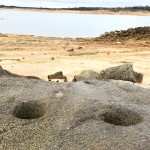
Get off the Peninsula trails and you might stumble upon old Native American grinding holes down by the lake.
We know that acorns were gathered in the fall by Native Americans and the women would peal the pericarp or the thin fruit skin way from the acorn meat. The acorn meat would then be ground up in grind holes on top of granite boulders in the area. The meal or flour was then subjected to a water leaching process to remove tannic acid, a bitter compound. The acorn flour and water mixture was cooked in baskets by placing fire-hot rocks into them, similar to boiling porridge. Salt or other herbs and vegetables may have been added to the dish. Acorn cakes were also made by the Native Americans.
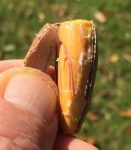
After clipping off either end of the acorn, I peeled away a small portion of the pericarp or skin. The rest of the acorn skin easily peels away.
Husking Coastal Live Oak Acorns
After gathering several hundred acorns from my backyard, I sat in the sun to husk the outer skin. I clipped both ends of the long acorns and then took a knife sliced a thin strip of the pericarp from end to end. It is fairly easy to peel away the rest of the skin. I husked about three cups of the acorn meat in this fashion.
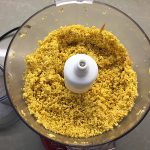
Instead of grinding the acorns in a granite boulder mortar, I used a food process to mince the acorns.
Processing Acorns Into Meal
Since I did not have a grinding hole in my backyard granite outcropping, I used a food processor to grind the acorn meat into a meal. The result was minced acorn meat akin to corn meal. I then placed the acorn meal in an old t-shirt and ran warm water over the meal. I also let it stand for an hour in the water trying to replicate the leaching process to remove the tannic acid. I was not entirely successful as I could still taste hints of the bitter compound after I cooked the acorn mush.
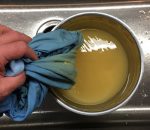
I attempted to leach the acorn meal of tannic acid by placing the meal in an old t-shirt and running warm water over it.
Leaching Out Tannic Acid
The remnants of the tannic acid I encountered were probably a result of the relatively large minced pieces of the acorn and a short leaching process. I would assume that grinding the acorns with a mortar and pestle – like the Native Americans did – probably yielded finer particles. Smaller particles would expose more of the meal to water to leach out the tannic acid.

I cooked my acorn meal like a breakfast cereal on the stove top. The meal went from a pale yellow to golden brown color.
Cooking Thanksgiving Acorn Mush
After leaching, I placed the meal in a pot on the stove top and cooked it like any breakfast cereal like Malt-O-Meal or corn meal. I slowly boiled the meal until it turned a golden brown color. The acorn meal absorbed most of the water and turned into a thick mush. I served it on my Thanksgiving plate and seasoned it with a little salt.
It really didn’t have much flavor, but it wasn’t disagreeable either. There was a slight bite from what I assume was the tannic acid that I failed to properly leach out. However, the bitterness is not necessarily a bad taste; it just isn’t a compliment to the overly savory Thanksgiving preparations that we juice up with sugar, salts and other fats.

My acorn mush complimented the other Thanksgiving meal preparations on my plate.
I can see why acorns were such stable of the Native American diet. Aside from the time consuming preparation work to husk and grind the acorns, they really do provide quite a hearty meal. They are a fairly high energy source with good mix of carbohydrates, fat, and protein. While I probably won’t cook a batch of acorn mush anytime soon, I can see how such an activity would be a good educational activity for school children or introduction to the Native American lifestyle before it was so abruptly ended with the mass immigration of gold miners into California.


